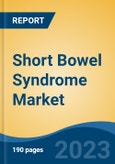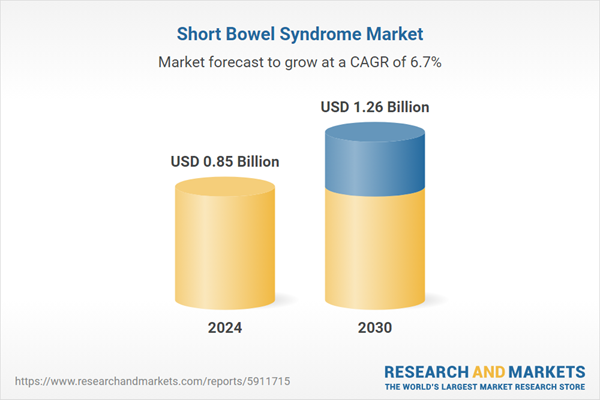Speak directly to the analyst to clarify any post sales queries you may have.
10% Free customizationThis report comes with 10% free customization, enabling you to add data that meets your specific business needs.
SBS typically arises from the surgical removal or damage of a substantial portion of the small intestine, often caused by factors such as congenital defects, trauma, or diseases like Crohn’s disease. According to a recent study titled "Crohn’s Disease Phenotypes and Associations With Comorbidities, Surgery Risk, Medications, and Nonmedication Approaches: The MAGIC in IMAGINE Study", a study in Japan on 673 newly diagnosed adults with Crohn’s disease (CD) found that 63% exhibited an inflammatory phenotype, 60% had ileocolonic disease, and 49% had perianal lesions, with the prevalence of perianal disease (such as abscesses or fistulas) being notably high. Studies across Asia have reported even higher rates of inflammatory disease, ranging from 66% to 81%.
Key Market Drivers
The increasing incidence of Short Bowel Syndrome is driving market growth. As the number of SBS cases rises, the demand for treatments and therapies has surged, contributing to the market's expansion. Pharmaceutical companies are heavily investing in research and development to create medications that enhance nutrient absorption for SBS patients and help them manage their condition. These innovations are a significant factor in the market’s growth. Parenteral nutrition, which delivers essential nutrients intravenously, has become a critical treatment for SBS patients, leading to a rise in demand for these solutions and associated equipment.Additionally, enteral nutrition, involving specialized formulas designed for SBS patients, plays a crucial role in managing the condition. Advances in minimally invasive surgical techniques and small bowel transplantation have also improved patient outcomes, further driving market expansion. Increased awareness of SBS and the advocacy efforts of patient groups have led to additional research funding and resources, fostering further market growth. Although SBS is rare, with an estimated prevalence of 1-2 cases per 100,000 individuals annually, its growing recognition is accelerating the development of treatment options.
Key Market Challenges
A major challenge for the SBS market is the limited patient pool. As SBS is classified as a rare disease, the number of diagnosed cases globally is relatively small, limiting the overall market size and the number of patients requiring specialized treatments. This restricted patient base can deter pharmaceutical companies from investing heavily in the development of new therapies, as the potential return on investment is lower. Consequently, promising treatments may not receive the attention they deserve, hindering progress in the field. Additionally, the fragmented nature of the patient pool complicates large-scale clinical trials and the collection of sufficient data to prove the efficacy of new therapies, creating a cycle of underinvestment and delayed progress.Key Market Trends
Technological advancements have significantly influenced the growth of the global SBS market. Recent medical innovations are improving the management and treatment of SBS, offering hope for affected individuals. Pharmaceutical companies are actively developing new drugs and therapies to address the causes and symptoms of SBS. A notable advancement is Zealand Pharma A/S's phase 3 study of Glepaglutide, a long-acting GLP-2 analog that could potentially outperform existing treatments, such as Teduglutide, due to its benefits, including weekly administration and extended action. Furthermore, the development of specialized nutritional supplements tailored for SBS patients has greatly improved their quality of life.Key Market Players
- Wellspect Healthcare (Dentsply Sirona Company)
- Emmaus Life Sciences, Inc.
- Merck & Co., Inc.
- Novartis AG
- OPKO Health, Inc.
- OxThera AB
- Pfizer Inc.
- Swedish Orphan Biovitrum AB
- Takeda Pharmaceutical Company Limited
- Teva Pharmaceutical Industries Ltd.
Report Scope
This report provides a detailed analysis of the global Short Bowel Syndrome market, segmented into the following categories, in addition to examining industry trends:
By Drug Class:
- GLP-2
- Glutamine
- Growth Hormone
By Distribution Channel:
- Hospital Pharmacies
- Online Sales
- Retail Pharmacies
By Region:
North America:
- United States
- Canada
- Mexico
Europe:
- France
- United Kingdom
- Italy
- Germany
- Spain
Asia-Pacific:
- China
- India
- Japan
- Australia
- South Korea
South America:
- Brazil
- Argentina
- Colombia
Middle East & Africa:
- South Africa
- Saudi Arabia
- UAE
Competitive Landscape
This report includes detailed profiles of the leading companies operating in the SBS market.Available Customizations: TechSci Research offers tailored customizations of the Global Short Bowel Syndrome market report to meet specific business requirements. The following customization options are available:
Company Information:
In-depth analysis and profiling of additional market players (up to five).This product will be delivered within 1-3 business days.
Table of Contents
Companies Mentioned
- Wellspect Healthcare (Dentsply Sirona Company)
- Emmaus Life Sciences, Inc.
- Merck & Co., Inc.
- Novartis AG
- OPKO Health, Inc.
- OxThera AB
- Pfizer Inc.
- Swedish Orphan Biovitrum AB
- Takeda Pharmaceutical Company Limited
- Teva Pharmaceutical Industries Ltd.
Table Information
| Report Attribute | Details |
|---|---|
| No. of Pages | 185 |
| Published | February 2025 |
| Forecast Period | 2024 - 2030 |
| Estimated Market Value ( USD | $ 0.85 Billion |
| Forecasted Market Value ( USD | $ 1.26 Billion |
| Compound Annual Growth Rate | 6.7% |
| Regions Covered | Global |
| No. of Companies Mentioned | 10 |









